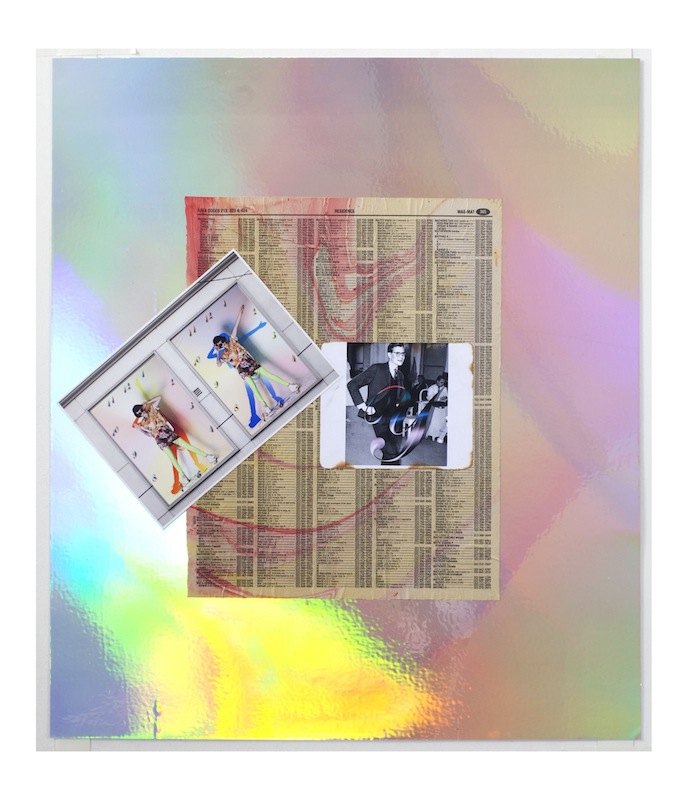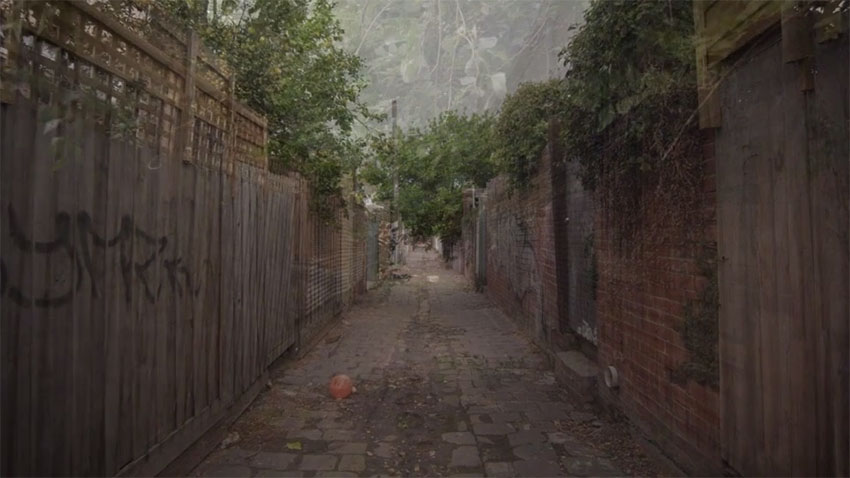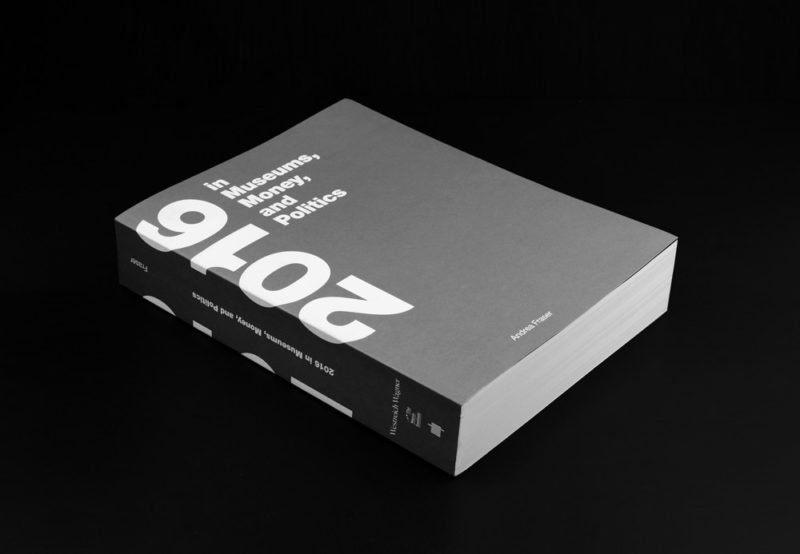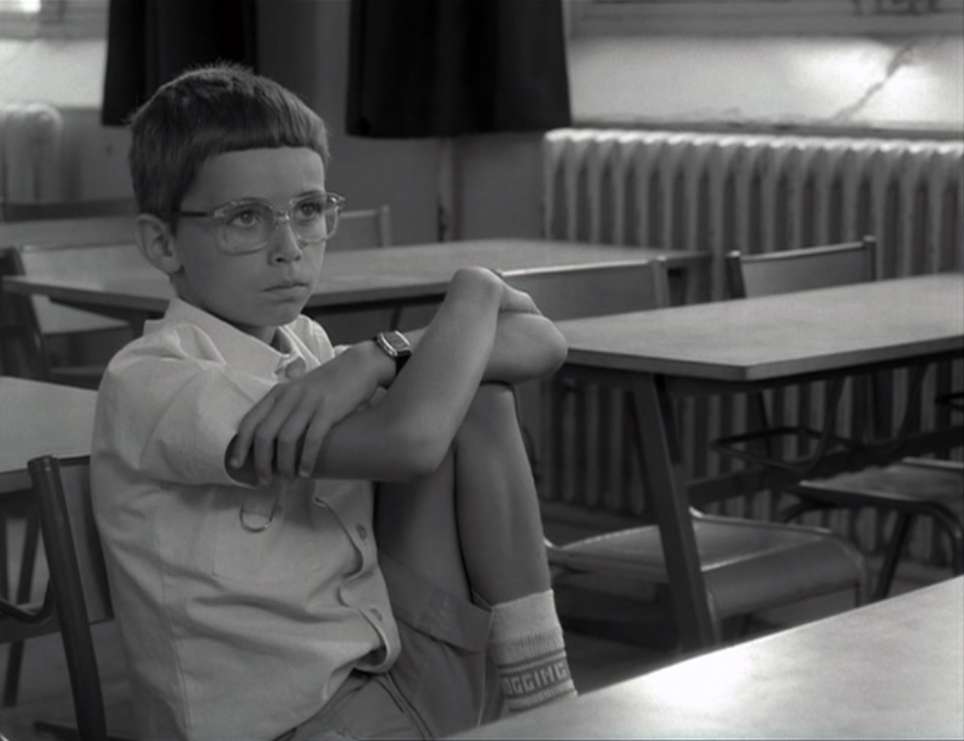
© » KADIST
Daniel Gustav Cramer
Drawing & Print (Drawing & Print)
David Gustav Cramer’s are composed of simple, descriptive texts accompanied by found photographs, letters or other materials. The elements juxtaposed in each work operate like the lines of a Haiku. It is the tension between them that opens space for thought.

© » KADIST
Daniel Boyd
Daniel Boyd’s work WTEIA3 is part of a series of paintings that reference the stick charts used by indigenous communities on the Marshall Islands. These charts were made in order to navigate the Pacific ocean by canoe and thus crucially depict ocean swell patterns. These highly individualised maps were rarely intended for mass use but instead for memorising, and transmitting between the community, the maps were not taken to sea but instead memorised in advance.

© » KADIST
Daniela Ortiz
The Rebellion of Roots by Daniela Ortiz depicts a series of situations in which tropical plants, held hostage in the botanical gardens and greenhouses of Europe, are protected and nurtured by the spirits of racialized people who died as a result of European racism. The work is divided into four short stories: About Afghanistan and heroin , About Exposition Colonial and cow , About Jardin d’acclimatation and potato , and About Vietnam . The series of 14 painted panels draw upon the aesthetic of ex-votos, a genre of traditional religious folk painting that acts as a tribute for divine intervention in response to personal tragedy.

© » KADIST
Daniela Ortiz
Previously, Ortiz produced a series of photographs related to her research on the position of ‘service architecture’, the vital space given to domestic servants in the modernist architectural houses of South American upper class families. Following the same formal principal, she has developed a new series called Estat nacio . This work presents a critical point of view on the construction of a national sovereignty through speeches and laws concerning people who are not considered as citizens according to immigration legislation and the regulations affecting immigrants’ rights and freedom.

© » KADIST
Daniel Joseph Martinez
Martinez’s sculpture A meditation on the possibility… of romantic love or where you goin’ with that gun in your hand , Bobby Seale and Huey Newton discuss the relationship between expressionism and social reality in Hitler’s painting depicts the legendary Black Panther leaders Huey P. Newton and Bobby Seale. By using Carrara marble, a material usually associated with heroic public sculptures, Martinez casts the history of African-American revolutionaries into the artistic tradition of monumentality. Like the artist’s earlier work included in the 1993 Whitney Biennial, an interactive piece made up with pins that read, “I CAN’T IMAGINE EVER WANTING TO BE WHITE,” A meditation on the possibility… continues Martinez’s effort to expose cultural contradictions and increase public awareness.

© » KADIST
Daniel Joseph Martinez
Drawing & Print (Drawing & Print)
If Only God Had Invented Coca Cola Sooner! Or, The Death of My Pet Monkey

© » KADIST
Daniel Joseph Martinez
For I use to eat lemon meringue pie till I overloaded on my pancreas with sugar and passed out; It seemed to be a natural response to a society of abundance (1978), also known as the Bodybuilder series, Martinez asked male bodybuilding competitors to pose in whatever position felt “most natural.” They are obviously trained in presenting their ambitiously carved physiques, but their facial expressions seem comparatively unstudied. Against a bare white background, the men appear unexpectedly vulnerable, caught between performance and rehearsal, public and private. While they present themselves deliberately as exemplars of strength, they also inadvertently expose something about the value system that underlies their endeavors—whatever drove them to keep building by tearing tissue, and whatever makes flexing feel like the most honest pose possible.

© » KADIST
Carter Mull
Mull’s Worker’s Clock collage works bring together images from the artist’s studio photography practice, found photographs, and pages from a phone book, laying them over a psychedelic warp of color in the background. One of the images is borrowed from a billboard, Double Block (for Alanna Pearl, Nik Nova and R. Mutt) (2013) that Mull created to hang above some storefronts in downtown Los Angeles. The pair of photographs features a woman posed in the center for rings of numbers, her body and shadow taking the place of the mechanical hands.

© » KADIST
Carter Mull
Mull’s Worker’s Clock collage works bring together images from the artist’s studio photography practice, found photographs, and pages from a phone book, laying them over a psychedelic warp of color in the background. One of the images is borrowed from a billboard, Double Block (for Alanna Pearl, Nik Nova and R. Mutt) (2013) that Mull created to hang above some storefronts in downtown Los Angeles. The pair of photographs features a woman posed in the center for rings of numbers, her body and shadow taking the place of the mechanical hands.

© » KADIST
Carmen Winant
Hand Study (Making in Whiteness) IIII by Carmen Winant is part of a series of five collages. For this series, Winant hand cut approximately 3000 images from manuals of craft (mostly pottery) dating from the 1930s-1990s. The artist selected this period of time before the advent of digital photography, when many of the books were handset by artists and artisans, embedded with minor imprecisions and printed affordably.

© » KADIST
Shilpa Gupta
In Untitled (Sword) , addressing histories of colonialism with abstraction, a large steel blade extends from the gallery wall. Its severed tip dangles from the end of the blade by a string, floating just above the gallery floor.

© » KADIST
Shilpa Gupta
Drawing & Print (Drawing & Print)
These hand drawn maps are part of an ongoing series begun in 2008 in which Gupta asks ordinary people to sketch outlines of their home countries by memory. Gupta created each map by superimposing 100 separate drawings of each country. The project investigates modern notions of the nation-state, national identity, and borders by looking at countries in which boundaries are contested and the history of the land far precedes such ideas.

© » KADIST
Danielle Dean
In True Red Ruin (Elmina Castle) , Danielle Dean uses archival documents to re-imagine colonial history from the 1400s, while also referencing her own personal history. Elmina Castle was built in Ghana in 1482 as a Portuguese trading post, and later became a key location in the Atlantic slave trade. Dean’s re-enactment is set in an affordable housing community in Houston, Texas, where her half-sister Ashstress Agwunobi lives, and who also performs the role of “the native.” Dean plays the role of “the prospector,” who plans to “colonize” her sister’s home by bringing a wobbly red cardboard castle into the grounds of the community and getting the locals to help build it and work there.

© » KADIST
Danielle Dean
Hexafluorosilicic acid is a type of sodium fluoride waste product that can be found in a large amount of widely available products such as cleaning fluids, toothpaste, rat poison, and drinking water. In Danielle Dean’s video Hexafluorosilicic , she mulls on this substance and its troubling co-option by modern society. In an indistinct US city, in an empty apartment, three characters (one of whom, unusually for Dean, is a white male) all wear brightly colored medical scrubs and undertake seemingly trivial and nonsensical experiments.

© » KADIST
Danielle Dean
No Lye by Danielle Dean documents a group of five women, including Dean herself, confined to a small, cramped bathroom, communicating only by using slogans culled from beauty advertisements (“beauty is skin deep”, “naturalise, it’s in our nature to be strong and balanced”) and quotes from political speeches (“we must protect our borders”, “we are fighting for our way of life and our ability to fight for freedom”). The result is a fragmented conversation that defies legibility. As sounds of a possible conflict rise from outside, the characters work together producing what looks like explosives from soap, towels, and an unmarked blue liquid.

© » KADIST
Manuel Correa
Manuel Correa’s short film Didn’t Know I Died is a testimonial portrait of the acclaimed Colombian poet Olga Elena Mattei. Earlier in her life during a simple medical operation, Mattei was declared medically dead. In the film, she recounts her first memory upon waking up, a dream.

© » KADIST
Manuel Correa
Manuel Correa’s documentary Four Hundred Unquiet Graves is a powerful and vulnerable visual essay about the descendants of those who were disappeared during the Spanish Civil War from 1936–1939. The film reveals the spectrum of violence that surrounds the war, namely the impact of thousands of forced disappearances on different generations. Surviving family members are haunted not only by the absence of their grandparents, but also by the overwhelming grief that lives in their parents.

© » KADIST
Manuel Correa
La Forma del Presente (The Shape of Now) by Manuel Correa follows a group of survivors of Colombia’s 50-year long armed conflict facing the impossible task of agreeing on a shared past. After half a century of carnage, Colombia achieved peace. Despite an agreement between the government and the Revolutionary armed forces of Colombia (FARC_EP) being rejected by popular vote, the government chose to implement the agreements regardless, further polarizing the public opinion.

© » KADIST
Daniel Keller
To make the video installation Soft Staycation (Gaze Track Edit) , the artist, playing the role of ‘job creator’, hired a group of unemployed and expat freelancers through Craigslist to watch a 30 minute compilation of national tourism ads. These ads, which are generally sponsored by various publicly funded tourism boards and screened in airports for example, were found on the Internet by Keller. He used a gaze-tracking camera to measure the eye movements of the people participating in the experiment.

© » KADIST
Daniel Crooks
The Illusion of Everything (2014) follows an unseen pedestrian as he navigates the Australian city of Melbourne’s dense and intricate network of laneways. The video begins with the pedestrian traversing a seemingly idyllic ivy lined stone and concrete thoroughfare. As his pace begins to accelerate, the camera follows him with greater urgency, slowly settling and become stable again as his pace decelerates.

© » KADIST
Daniel Boccato
Parrot Drawings or Paintings look like children’s drawings and seem quite innocent. The parrot in both the Garden of Eden and the harems are associated with the symbol of purity and innocence. These symbols are found in Renaissance painting, especially in the Annunciations or the Virgins and child and later in Flemish portraits.

© » KADIST
Daniel Boccato
Birdstones is a series of flat concrete slabs made from moldings of different shapes, each with two small holes. They stand vertically in space in a precarious stance. Heavy by the density of the concrete, they are also airy and floating.

© » KADIST
Daniela Ortiz
In her work, Maids Room (2012) which is part of a series, Daniela Ortiz undertakes an architectural analysis of the houses belonging to the upper class of Lima. Her research highlights the position of ‘service architecture’, the vital space given to the domestics. The project offers an analysis of this room, its size and its position in relation to the rest of the house.

© » KADIST
Andrea Fraser
Drawing & Print (Drawing & Print)
The year 2016 is organized like a telephone book; the data corresponding to the contributions are classified in alphabetical order by the name of the donor. With this database as well as other types of information, the 900-page book presents a material representation of the scale of the cross over between cultural philanthropy and the financing of political campaigns in America. It also provides an unprecedented resource for discovering the political leaning of the museum sector.

© » KADIST
Geoffrey Farmer
Ongoing Time Stabbed with a Dagger was Farmer’s first kinetic sculpture that added a cinematic character to an “ever-reconfiguring play presented in real time.” The assembly of various objects and props on top of a large platform constitutes not only a work, but, to a certain extent, a show in itself. The title of the piece comes from the literal translation of René Magritte’s painting from 1938, La Durée Poignardée , whose more familiar translation is “Time Transfixed.”

© » KADIST
Daniel Steegmann Mangrané
In the hologram “Mano con hojas” (”Hand with Leaves”, 2013), nature is portrayed simultaneously as an interconnected system of processes and the essence of the universe. A change in the understanding of nature challenges the understanding of our own natures. The visual metaphor of the human hand enmeshed and inextricably entangled with leaves suggests that humans cannot be divorced from nature, and moreover that they are always engaging with the problematic of overtaking nature or being overtaken by it.

© » KADIST
Shilpa Gupta
Drawing & Print (Drawing & Print)
These hand drawn maps are part of an ongoing series begun in 2008 in which Gupta asks ordinary people to sketch outlines of their home countries by memory. Gupta created each map by superimposing 100 separate drawings of each country. The project investigates modern notions of the nation-state, national identity, and borders by looking at countries in which boundaries are contested and the history of the land far precedes such ideas.

© » KADIST
Camel Collective
Gated Commune , a video by Camel Collective, is a critique of the complex, and often obtuse, language used to describe sustainable development projects. To construct a future scenario in the imagination of the viewers, a voiceover narrates two perspectives of futuristic practices in architecture and social behaviors: neo-primitives on one hand, who value organic materials and design based on geometric forms, and futurists on the other hand, who value organic forms and computer design. In this constructed universe, both perspectives lead to societal structures that malfunction due to issues with their design, which are not in line with their users’ needs.

© » KADIST
Camel Collective
Something Other Than What You Are by Camel Collective is formed by two works: a multi-channel video installation with controlled lighting, and a single-channel version with stereo sound. In both works, the 36 minute video depicts a narrative taking place outside of a live theater performance in the form of monologues that moves between the production and technical crew. There is a set of three different characters—a lighting technician, a lighting designer, and a professor all played by the same actress who share in their personal experiences and attitudes the precariousness of their work, the problems and myths of collaboration, and the obsolescence of theatrical technology.

© » KADIST
Shilpa Gupta
The three monkeys in Don’t See, Don’t Hear, Don’t Speak are a recurring motif in Gupta’s work and refer to the Japanese pictorial maxim of the “three wise monkeys” in which Mizaru covers his eyes to “see no evil,” Kikazaru covers his ears to “hear no evil,” and Iwazaru covers his mouth to “speak no evil.” For the various performative and photographic works that continue this investigation and critique of the political environment, Gupta stages children and adults holding their own or each other’s eyes, mouths and ears. These images suggest that seemingly mobilized societies can actually produce more fear and myths, and that no real freedom is ensured. Instead of facilitating the free circulation of ideas, “advanced” political and technological systems often generate more cultural clichés, wars, and terror.
Shilpa Gupta
- location: Mumbai, India
- year born: 1976
- gender: female
- nationality: Indian
- home town: Mumbai, India
Danielle Dean
Danielle Dean creates videos that use appropriated language from archives of advertisements, political speeches, newscasts, and pop culture to create dialogues to investigate capitalism, post-colonialism, and patriarchy...
Daniel Joseph Martinez
- location: Los Angeles, California
- year born: 1957
- gender: male
- nationality: American
- home town: Los Angeles, California
Manuel Correa
Manuel Correa’s practice deals with the reconstruction of post-conflict intergenerational memory in contemporary societies...
Daniela Ortiz
In order to reveal and critique hegemonic structures of power, Daniela Ortiz constructs visual narratives that examine concepts such as nationality, racialization, and social class...
Carter Mull
Los Angeles-based artist Carter Mull is an obsessive sort, and his fascinations show through in his multimedia photographic and installation-based works...
Daniel Boccato
The work of Daniel Boccato deals with the relationships between form and language, abstraction and figuration, and forces the viewer to try to name, categorize and differentiate...
Camel Collective
Camel Collective comprises the artists Carla Herrera-Prats (Mexican, photographer and conceptual artist) and Anthony Graves (American, painter), who began working together in 2005 during a fellowship at the Whitney Independent Program...
Daniel Boyd
Daniel Boyd is an indigenous Australian Pacific artist, in his practice he combines references to both Aboriginal art and international contemporary art, displaying a strong political commitment...
Andrea Fraser
- location: Montana, United States
- year born: 1965
- gender: female
- nationality: American
Miguel Angel Rojas
For Colombian artist Miguel Ángel Rojas, issues of economic and social inequality in his native country provide fodder to his artistic practice...
Carmen Winant
Carmen Winant is one of the leading artists who exclusively uses found images in a photographic practice that takes the form of collages, sculptures, artist books, billboards, and wall installations...
Geoffrey Farmer
- location: Vancouver, British Columbia
- year born: 1967
- gender: male
- nationality: Canadian
- home town: Eagle Island, Canada
Jane Jin Kaisen and Guston Sondin-Kung
Working with narrative experimental film, multi-channel video installation, performative video art, photography, and text, Jane Jin Kaisen engages themes of memory, trauma, migration and translation at the intersection of personal and collective histories...
Daniel Keller
Daniel Keller belongs to a generation of artists born at the end of the 1980s, nourished by digital imagery, who have participated in the social networks as a communication strategy, combining the public and the private spheres; a logical heir to the “entrepreneur” artist of 1990-2000...
Daniel Crooks
- year born: 1973
- gender: male
- nationality: New Zealander
- home town: Hastings, New Zealand
Gisela McDaniel
Chamorro artist Gisela McDaniel depicts Native American and mixed-race women from the USA’s former, as well as current, Pacific territories...
Manuel Solano
Manuel Solano, who is non-binary and prefers plural pronouns, was an emerging 26-year-old artist when they lost their sight to an HIV-related infection in 2013...
-
1970-1979
Daniel Joseph Martinez
1978For I use to eat lemon meringue pie till I overloaded on my pancreas with sugar and passed out; It seemed to be a natural response to a society of abundance (1978), also known as the Bodybuilder series, Martinez asked male bodybuilding competitors to pose in whatever position felt “most natural.” They are obviously trained in presenting their ambitiously carved physiques, but their facial expressions seem comparatively unstudied...
-
1980-1989
Jean-Marie Straub and Danièle Huillet
1982En rachâchant is based on the short story Ah! Ernesto! (1971) by Marguerite Duras in which the child Ernesto does not want to go to school anymore as all that he is taught are things he does not know...
-
2000-2009
Daniel Joseph Martinez
2005Martinez’s sculpture A meditation on the possibility… of romantic love or where you goin’ with that gun in your hand , Bobby Seale and Huey Newton discuss the relationship between expressionism and social reality in Hitler’s painting depicts the legendary Black Panther leaders Huey P...
Shilpa Gupta
2008The three monkeys in Don’t See, Don’t Hear, Don’t Speak are a recurring motif in Gupta’s work and refer to the Japanese pictorial maxim of the “three wise monkeys” in which Mizaru covers his eyes to “see no evil,” Kikazaru covers his ears to “hear no evil,” and Iwazaru covers his mouth to “speak no evil.” For the various performative and photographic works that continue this investigation and critique of the political environment, Gupta stages children and adults holding their own or each other’s eyes, mouths and ears...
Shilpa Gupta
2009In Untitled (Sword) , addressing histories of colonialism with abstraction, a large steel blade extends from the gallery wall...
Geoffrey Farmer
2009Ongoing Time Stabbed with a Dagger was Farmer’s first kinetic sculpture that added a cinematic character to an “ever-reconfiguring play presented in real time.” The assembly of various objects and props on top of a large platform constitutes not only a work, but, to a certain extent, a show in itself...
-
2010-2019
Jane Jin Kaisen and Guston Sondin-Kung
2010The Woman, The Orphan, and The Tiger begins with the sound of women’s voices describing histories of violence, of things repressed and silenced...
Miguel Angel Rojas
Drawing & Print
2011(Drawing & Print) In his paper-based work, Medellin-New York , Rojas uses coca leaves and dollar bills to spell out the words of the two cities, tied together through the illicit exchange of materials used to make the word, gesturing towards the uncomfortable reality of the drug trafficking trade and the complicity of both America and Colombia within that economic system....
Danielle Dean
2012No Lye by Danielle Dean documents a group of five women, including Dean herself, confined to a small, cramped bathroom, communicating only by using slogans culled from beauty advertisements (“beauty is skin deep”, “naturalise, it’s in our nature to be strong and balanced”) and quotes from political speeches (“we must protect our borders”, “we are fighting for our way of life and our ability to fight for freedom”)...
Daniela Ortiz
2012In her work, Maids Room (2012) which is part of a series, Daniela Ortiz undertakes an architectural analysis of the houses belonging to the upper class of Lima...
Miguel Angel Ríos
2012Superb production values and special effects that in the hands of Miguel Angel Rios do not get in the way or distracts from the content and deep essay of this work...
Daniela Ortiz
2013Previously, Ortiz produced a series of photographs related to her research on the position of ‘service architecture’, the vital space given to domestic servants in the modernist architectural houses of South American upper class families...
Carter Mull
2013Mull’s Worker’s Clock collage works bring together images from the artist’s studio photography practice, found photographs, and pages from a phone book, laying them over a psychedelic warp of color in the background...
Carter Mull
2013Mull’s Worker’s Clock collage works bring together images from the artist’s studio photography practice, found photographs, and pages from a phone book, laying them over a psychedelic warp of color in the background...
Daniel Keller
2013To make the video installation Soft Staycation (Gaze Track Edit) , the artist, playing the role of ‘job creator’, hired a group of unemployed and expat freelancers through Craigslist to watch a 30 minute compilation of national tourism ads...
Daniel Steegmann Mangrané
2013In the hologram “Mano con hojas” (”Hand with Leaves”, 2013), nature is portrayed simultaneously as an interconnected system of processes and the essence of the universe...
Shilpa Gupta
Drawing & Print
2014(Drawing & Print) These hand drawn maps are part of an ongoing series begun in 2008 in which Gupta asks ordinary people to sketch outlines of their home countries by memory...
Daniel Crooks
2014The Illusion of Everything (2014) follows an unseen pedestrian as he navigates the Australian city of Melbourne’s dense and intricate network of laneways...
Shilpa Gupta
Drawing & Print
2014(Drawing & Print) These hand drawn maps are part of an ongoing series begun in 2008 in which Gupta asks ordinary people to sketch outlines of their home countries by memory...
Miguel Angel Ríos
2014For Piedras Blancas , arguably his most ambitious and visually arresting video to date, Miguel Angel Ríos made 3,000 “piedras” out of a concrete/stone composite...
Danielle Dean
2015Hexafluorosilicic acid is a type of sodium fluoride waste product that can be found in a large amount of widely available products such as cleaning fluids, toothpaste, rat poison, and drinking water...
João Maria Gusmão and Pedro Paiva
2015The artist duo João Maria Gusmão and Pedro Paiva traveled to Japan for a month to make a series of short 16mm films, often shot in slow-motion...
Daniel Boccato
2016Parrot Drawings or Paintings look like children’s drawings and seem quite innocent...
Danielle Dean
2016In 2003, Nike released a pair of red and black sneakers (the Dunk Low Pro SB ) that were marketed as “vampire” sneakers...
Daniel Boyd
2017Daniel Boyd’s work WTEIA3 is part of a series of paintings that reference the stick charts used by indigenous communities on the Marshall Islands...
Danielle Dean
2017In True Red Ruin (Elmina Castle) , Danielle Dean uses archival documents to re-imagine colonial history from the 1400s, while also referencing her own personal history...
Daniel Boccato
2017Birdstones is a series of flat concrete slabs made from moldings of different shapes, each with two small holes...
Manuel Correa
2018La Forma del Presente (The Shape of Now) by Manuel Correa follows a group of survivors of Colombia’s 50-year long armed conflict facing the impossible task of agreeing on a shared past...
Camel Collective
2018Gated Commune , a video by Camel Collective, is a critique of the complex, and often obtuse, language used to describe sustainable development projects...
Camel Collective
2018Something Other Than What You Are by Camel Collective is formed by two works: a multi-channel video installation with controlled lighting, and a single-channel version with stereo sound...
-
2020-2029
Daniel Gustav Cramer
Drawing & Print
2020(Drawing & Print) David Gustav Cramer’s are composed of simple, descriptive texts accompanied by found photographs, letters or other materials...
Manuel Correa
2020Manuel Correa’s short film Didn’t Know I Died is a testimonial portrait of the acclaimed Colombian poet Olga Elena Mattei...
Manuel Correa
2020Manuel Correa’s documentary Four Hundred Unquiet Graves is a powerful and vulnerable visual essay about the descendants of those who were disappeared during the Spanish Civil War from 1936–1939...
Andrea Fraser
Drawing & Print
2020(Drawing & Print) The year 2016 is organized like a telephone book; the data corresponding to the contributions are classified in alphabetical order by the name of the donor...
Gisela McDaniel
2020Got Your Back by Gisela McDaniel depicts two women of color from different ethnic backgrounds who share similar violent experiences...
Manuel Solano
2020Since Manuel Solano became blind, they developed a technique that relies on audio descriptions that allow for an assistant to place pins and threads on a grid that guides the artist’s hands through the surface...
Daniela Ortiz
2021The Rebellion of Roots by Daniela Ortiz depicts a series of situations in which tropical plants, held hostage in the botanical gardens and greenhouses of Europe, are protected and nurtured by the spirits of racialized people who died as a result of European racism...
Carmen Winant
2021Hand Study (Making in Whiteness) IIII by Carmen Winant is part of a series of five collages...








